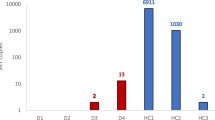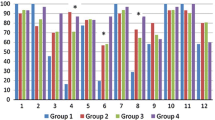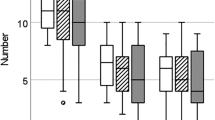Abstract
The major histocompatibility complex (MHC) imparts to each mouse an individual urinary odor, called “odortype”, which reflects its MHC genotype. Perception of odortypes affects mate selection and embryonic implantation. Recent findings that odortypes tre expressed as early as one day of age suggested that they might already be expressed in utero. We now report that at 9–12 days of gestation, odortypes specified by paternal (non-maternal) MHC haplotypes become apparent in maternal urine. Thus, odortypes are expressed in utero, can be sensed even before birth, and may serve in familial identification and communication.
Similar content being viewed by others
References
Boyse, E. A., Beauchamp, G. K., and Yamazaki, K. The genetics of body scent. Trends Genet 3: 97–102, 1987
Boyse, E. A., Beauchamp, G. K., Bard, J., and Yamazaki, K.. Behaviour and the major histocompatibility complex of the mouse. In R. Ader D. L. Felten, and N. Cohen (eds.): Psychoneuroimmunology II, pp. 831–846, Academic Press, San iego, 1991a
Boyse, E. A., Beauchamp, G. K., Yamazaki, K., and Bard, J. Genetic components of kin recognition in mammals. In P. G. Hepper (ed.): Kin Recognition, pp. 148–161, Cambridge University Press, 1991b
Brown, R. E., Singh, P. B., and Roser, B.. The major histocompatibility complex and the chemosensory recognition of of individuality in rats. Physiol Behav 40:64–73, 1987
Egid, K. and Brown, J. L. The major histocompatibility complex and female mating preferences in mice. Anim Behav 38 (3): 548–550, 1989
Farbman, A. I. Prenatal development of mammalian olfactory receptor cells. Chem Senses 11: 3–18, 1986
Hepper, P. G. Sibling recognition in the rat. Anim Behav 31: 1177–1191, 1983
Jaffe, L., Robertson, E. J., and Bikoff, E. K. Distinct patterns of expression of MHC class I and β2-microglobulin transcripts at early stages of mouse development. J Immunol 147: 2740–2750, 1991
Klein, J. Natural History of the Major Histocompatibility Complex, Wiley, New York, 1986
Manning, C. J., Wakeland, E. K., and Potts, W. K. Communal nesting patterns in mice implicate MHC genes in kin recognition. Nature 360: 581–583, 1992
Ozato, K., Wan, Y. J., and Orrison, B. M. Mouse major histocompatibility class I gene expression begins at midsomite stage and is inducible in earlier-stage embryos by interferon. Proc Natl Acad Sci USA 82: 2427–2431, 1985
Porter, R. H., Chernoch, J. M., and McLaughlin, F. J. Maternal recognition of neonates through olfactory cues. Physiol Behav 30: 151–154, 1983
Potts, W. K., Manning, C. J., and Wakeland, E. K. Mating patterns in seminatural populations of mice influenced by MHC genotype. Nature 352: 619–621, 1991
Schaal, B. and Orgeur, P. Olfaction in utero: can the rodent model be generalized? Q J Exp Psychol 44B: 245–278, 1992
Shepherd, G. M., Pedersen, P. A., and Greer, C. A. Development of olfactory specificity in the albino rat: a model system. In N. A. Krasnegor, E. M. Blass, M. A. Hofer, W. P. Smotherman (eds.): Perinatal Development, pp. 129–144, Academic Press, Orlando, 1987
Singh, P. B., Brown, R. E., and Roser, B. MHC antigens in urine as olfactory recognition cues. Nature 327: 161–164, 1987
Singh, P. B., Brown, R. E., and Roser, B. Class I transplantation antigens in solution in body fluids and in the urine. J Exp Med 168: 195–211, 1988
Yamaguchi, M., Yamazaki, K., Beauchamp, G. K., Bard, J., Thomas, L., and Boyse, E. A. Urinary odors governed by the major histocompatibility locus of the mouse. Proc Nat Acad Sci 78: 5817–5820, 1981
Yamazaki, K., Yamaguchi, M., Baranoski, L., Bard, J., Boyse, E. A., and Thomas, L. Recognition among mice: evidence from the use of a Y-maze differentially scented by congenic mice of different major histocompatibility types. J Exp Med 150: 755–760, 1979
Yamazaki, K., Beauchamp, G. K., Wysocki, C. J., Bard, J., Thomas, L., and Boyse, E. A. Recognition of H-2 types in relation to the blocking of pregnancy in mice. Science 221: 186–188, 1983
Yamazaki, K., Beauchamp, G. K., Thomas, L., and Boyse, E. A. The hematopoietic system is a source of odorants that distinguish major histocompatibility types. J Exp Med 162: 1377–1380, 1985
Yamazaki, K., Beauchamp, G. K., Kupniewwski, D., Bard, J., Thomas, L., and Boyse, E. A. Familial imprinting determines H-2 selective mating preferences. Science 240: 1331–1332, 1988
Yamazaki, K., Beauchamp, G. K., Imai, Y., Bard, J., Phelan, S. P., Thomas, L., and Boyse, E. A. Odortypes determined by the major histocompatibility complex in germfree mice. Proc Natl Acad Sci USA 87: 8413–8416, 1990
Yamazaki, K., Beauchamp, G. K., Imai, Y., Bard, J., and Boyse, E. A. Expression of H-2 odortypes by infant mice. Proc Nat Acad Sci USA 89: 2756–2758, 1992
Author information
Authors and Affiliations
Rights and permissions
About this article
Cite this article
Beauchamp, G.K., Yamazaki, K., Curran, M. et al. Fetal H-2 odortypes are evident in the urine of pregnant female mice. Immunogenetics 39, 109–113 (1994). https://doi.org/10.1007/BF00188613
Received:
Revised:
Issue Date:
DOI: https://doi.org/10.1007/BF00188613




